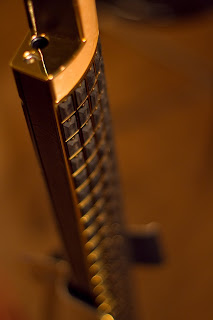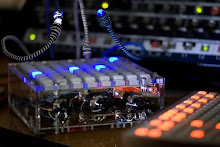

CDM posted a blog entry on the Eigenharp Alpha today and linked my video.
CDM on the Eigenharp Alpha
This is the perfect opportunity to write an entry that has been on my mind regarding this instrument. The topic being the supremely difficult task of bringing a radical instrument concept into the world.
I work in software technology and have been in and out of silicon valley startups, before and after the tech crash in 2001. One of the things that we talk about is the technology adoption curve. It takes awhile for a new technology whether it is disruptive or not to become accepted. Many times the companies that develop a new technology are not the ones to capitalize on it. This is because they may be a startup and can't stick it out for as long as it takes before the technology moves beyond early adopters and becomes mainstream. Many times a company that champions a new technology paves the way for others to take the concept further, once the market has started to accept it.
Take a look at at the adoption curve for a technology that I was involved with in the early days, "Web Services". It took a long time for Web Services to become adopted, but now it's a pervasive part of the technology landscape and the backbone of services such as Google, Amazon, Facebook and countless others.
Web Services Adoption Curve

Goeffrey Moore's famous book "Crossing the Chasm" has been required reading for generations of technology leaders. The chasm is the gap between early adopters and the rest of the curve.
Crossing the Chasm on Wikipedia

I think this is fairly relevant to the Eigenharp. Not only is it a revolutionary technology as far as the resolution of the keys and the bandwidth of the information flowing through it, but it is also radical in the sense that it doesn't copy an existing instrument form. Sure it has pieces of different instruments, keys. breath pipe, but really there is no previously existing instrument that prepares you for playing the eigenharp. There is no established method for technique or standard chord positions. It's really a new thing. This is difficult because beyond just the technology adoption curve, you also have a learning curve. It's as if the guitar was just thrown into the world new and there were a half dozen people trying to figure out how to play Stairway to Heaven.
Add to that difficulty, the fact that external software instruments and DAWs and such are still stuck at MIDI resolution, so you don't yet have a virtuous circle where the resolution of the eigenharp can be full expressed through the entire ecosystem of plugins and electronic sound engines.
Right now, the players are early adopters. And who is a candidate early adopter? Well I can see already that programmers are drawn to it. Why? We are comfortable with technology. We are drawn to the pure technical innovation it represents. We make a decent income and can afford it. We are already geeks, so we are not afraid to be labeled one? This is challenging because maybe it would be better to have early adopters that were "musicians" first and foremost. I think this will happen, but it will take time, and time is expensive.
Now the good news is that Eigenlabs seems to be fairly well funded and capable of riding the curve. If you can make a business with early adopters, then hopefully you can cross the chasm.
The one thing I do wish for is for the promise of open-sourcing the software to be realized, as that has enormous benefits for building a community of contributors to the platform. If your early adopters are programmers, that's a lot of talent that could be working for you. John Lambert, the chairman of Eigenlabs has already promised that this will happen although it is already 5 months behind schedule while details and licensing are worked out. I believe that this will be critical to their long term success. I do believe John when he says he is absolutely committed to doing it.
As I have said before, this is a wonderfully expressive instrument. It's a joy to play and I hope that we will see better and better things come out of it.




